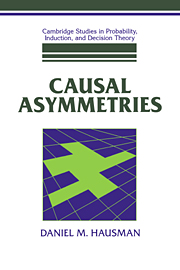Book contents
- Frontmatter
- Contents
- List of Figures
- Acknowledgments
- Introduction: Causation and its Asymmetries
- 1 Metaphysical Pictures and Wishes
- 1* Transfer Theories
- 2 Is Causation a Relation Among Events?
- 3 Causation, Regularities, and Time: Hume's Theory
- 4 Causation and Independence
- 4* Causation, Independence, and Causal Connection
- 5 Agency Theory
- 5* Causal Generalizations and Agency
- 6 The Counterfactual Theory
- 6* Independence and Counterfactual Dependence
- 7 Counterfactuals, Agency, and Independence
- 7* Agency, Counterfactuals, and Independence
- 8 Causation, Explanation, and Laws
- 8* Causation, Explanation, and Independent Alterability
- 9 Probabilistic Causation
- 10 Causation and Conditional Probabilities
- 10* Causal Graphs and Conditional Probabilistic Dependencies
- 11 Intervention, Robustness, and Probabilistic Dependence
- 11* Interventions and Conditional Probabilities
- 12 Operationalizing and Revising the Independence Theory
- 12* Probability Distributions and Causation
- 13 Complications and Conclusions
- Appendix A Alphabetical List of Propositions
- Appendix B List of Theorems
- References
- Index
6 - The Counterfactual Theory
Published online by Cambridge University Press: 20 April 2010
- Frontmatter
- Contents
- List of Figures
- Acknowledgments
- Introduction: Causation and its Asymmetries
- 1 Metaphysical Pictures and Wishes
- 1* Transfer Theories
- 2 Is Causation a Relation Among Events?
- 3 Causation, Regularities, and Time: Hume's Theory
- 4 Causation and Independence
- 4* Causation, Independence, and Causal Connection
- 5 Agency Theory
- 5* Causal Generalizations and Agency
- 6 The Counterfactual Theory
- 6* Independence and Counterfactual Dependence
- 7 Counterfactuals, Agency, and Independence
- 7* Agency, Counterfactuals, and Independence
- 8 Causation, Explanation, and Laws
- 8* Causation, Explanation, and Independent Alterability
- 9 Probabilistic Causation
- 10 Causation and Conditional Probabilities
- 10* Causal Graphs and Conditional Probabilistic Dependencies
- 11 Intervention, Robustness, and Probabilistic Dependence
- 11* Interventions and Conditional Probabilities
- 12 Operationalizing and Revising the Independence Theory
- 12* Probability Distributions and Causation
- 13 Complications and Conclusions
- Appendix A Alphabetical List of Propositions
- Appendix B List of Theorems
- References
- Index
Summary
Chapter 3 explored the possibilities of explaining the asymmetry of causation in terms of the relations between causation and time. Chapter 5 explored the possibilities of generating a theory of causal asymmetry from the connections between causation and agency. This chapter explores another attractive set of connections -those between causation and counterfactuals. When one asserts that one event a causes another distinct event b, then it seems that one is committed to the counterfactual: “If a had not occurred, then b would not have occurred either.” Hume himself wrote “ … we may define a cause to be an object, followed by another, and where all the objects similar to the first, are followed by objects similar to the second. Or in other words, where if the first object had not been, the second had never existed’ (Inquiry p. 51). The “other words” here are indeed “other words.” Hume seems mid-definition to leap from a regularity to a counterfactual theory of causation. This chapter explores the possibility of constructing a counterfactual theory of causation.
Lewis's Theory
According to David Lewis, if a and b are distinct events that actually occur, then b causally depends on a if and only if, if a were not to occur, then b would not occur either (1973a). If the match had not been struck, then it would not have lit. In Lewis's usage (in contrast to mine), “causal dependence” is a relation among token events, which is sufficient for causation. It is not the same thing as causation, because in cases of preemption it is not transitive.
- Type
- Chapter
- Information
- Causal Asymmetries , pp. 111 - 130Publisher: Cambridge University PressPrint publication year: 1998

